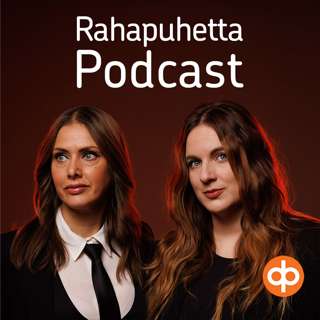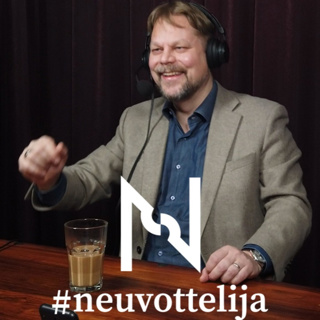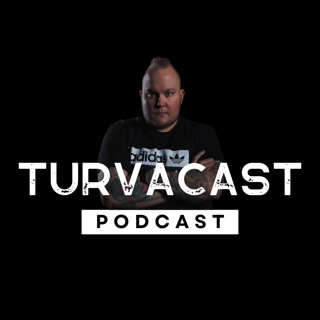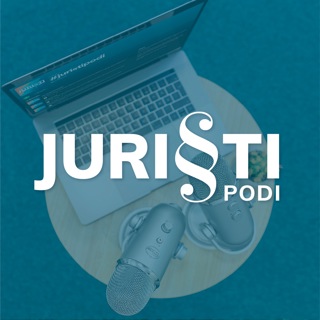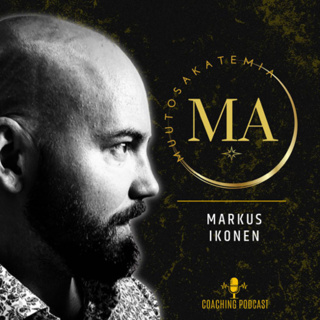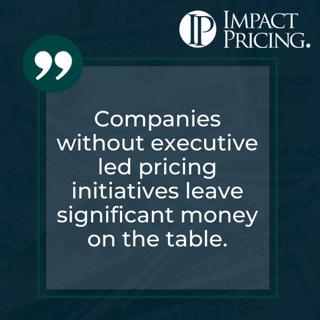
Memecast #53: Executive Led Initiatives
Let's face it, pricing people, we're typically smart. We have to interact and interface with lots and lots of different departments. But we rarely have the authority to make decisions that impact the entire company. These decisions could be changing pricing strategies, changing pricing metrics, focusing on market segments that we're going to go target. It could be getting product people to use value as they make decisions on which products to buy, or marketing people to document what value looks like as they're doing their marketing messages, teaching salespeople how to sell value. All of these are crucial when it comes to us helping the company win more deals at higher prices, but we don't have authority. What we do have is the knowledge typically to help these things happen. The only people in the company who have the authority to force these things through, to convince people who might be reluctant to say, "Yes, okay, let's go try it," are executives. If we don't have executives driving pricing initiatives, or even better yet, driving a culture of value. If our executives aren't doing this, we're leaving significant money on the table because there are lots of opportunities for us to go increase profit, we just don't have the authority. We hope you enjoyed this memecast. If you have any questions or feedback, please email me mark@impactpricing.com. Now, go make an impact. Connect with Mark Stiving: Email: mark@impactpricing.com LinkedIn: https://www.linkedin.com/in/stiving/
13 Huhti 20222min
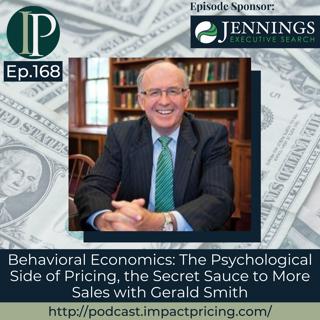
Behavioral Economics: The Psychological Side of Pricing, the Secret Sauce to More Sales with Gerald Smith
Gerald Smith is a Professor of Marketing at Boston College. He's been a Pricing Consultant with Strategic Pricing Group and Monitor Group since 1987. Gerald is the author of a relatively new book, “Getting Price Right: The Behavioral Economics of Profitable Pricing”. In this episode, Gerald discusses the power psychology holds in pricing in relation to behavioral economics as he talks about the soft side of pricing alongside the importance of framing. Why you have to check out today’s podcast: Find out what the hard side and soft side of pricing are all about, and why the behavioral side of pricing is more powerful than the logical side Understand why companies do framing, as well as why a frame of reference is important in pricing Discover why there’s power in psychology when talking about behavioral economics “Ask yourself and ask your pricing team, what do customers get and what do they pay for what they get? And say, is everybody in the industry doing it the same way?” – Gerald Smith Topics Covered: 01:39 – The start of Gerald’s pricing journey with Thomas Nagle and Reed Holden 03:08 – Gerald talks about his dissertation in relation to his new book, Getting Price Right 04:33 – The behavioral/soft side as potentially more powerful than the logical side 06:39 – The main point of Getting Price Right – the psychology of the sellers, the people that really set price 09:11 – Talking about the dominant pricing bias of salespeople giving discounts all the time 13:07 – Pricing strategy vs. pricing orientation 15:15 – Framing as one of the foundational theories of economics 18:09 – Discussion about Apple’s pricing slogan and the company having huge margins 22:45 – The power of behavioral economics – psychology; analysis vs. gut 24:12 – Talking about frame of references and setting price metrics 27:45 – Gerald’s piece of pricing advice for today’s listeners Key Takeaways: “We always think of pricing as a hard skill, as a quantitative skill. My students say to me, ‘Professor, tell me the formula for setting price.’ And I say, ‘No, no, no, folks.’ I mean, pricing is a soft skill that also brings in hard skills, for sure, so there are both skill sets.” – Gerald Smith “Sellers are also psychological and absolutely driven by psychology.” – Gerald Smith “One of the very dominant biases in pricing is that people have a tendency to discount price all the time. It's very irrational, and it, in fact, violates the principles of both psychology but especially economics, because economics says that people should rationally maximize the profits of the outcomes that are before them. And in the case of many people that apply this kind of discounting bias, they don't focus on the profits; they focus on the sales, and sales are not profits.” – Gerald Smith “Salespeople that work for somebody else are more likely to discount, but salespeople that do their own thing are less likely to discount. When they're selling their own place, they want to make sure that they maximize their profits if they can, but if they're selling for somebody else, they're happy to take that deal. That's because they get paid a commission on the deal. It is endemic to the world of pricing that people do this.” – Gerald Smith “Psychology is powerful. Analysis is terrific, but psychology is absolutely vital.” – Gerald Smith “Consumers or buyers give, but they also get. And so, if I can change what they get and what they give, then that can be very powerful.” – Gerald Smith People / Resources Mentioned: Getting Price Right: The Behavioral Economics of Profitable Pricing: https://www.amazon.com/Getting-Price-Right-Behavioral-Profitable/dp/0231190700 Freakonomics: A Rogue Economist Explores the Hidden Side of Everything: https://www.amazon.com/Freakonomics-Economist-Explores-Hidden-Everything/dp/0060731338 Connect with Gerald Smith: LinkedIn: https://www.linkedin.com/in/dr-gerald-smith-91b8383 Email: gerald.smith@bc.edu Connect with Mark Stiving: LinkedIn: https://www.linkedin.com/in/stiving/ Email: mark@impactpricing.com
11 Huhti 202230min
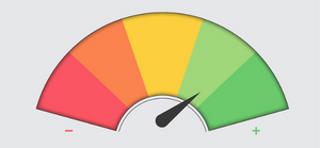
Blogcast #49: Indirect Customer Impact
This is an Impact Pricing Blog published on March 2, 2022, turned into an audio podcast so you can listen on the go. Read Full Article Here: https://impactpricing.com/blog/indirect-customer-impact/ If you have any feedback, definitely send it. You can reach us at mark@impactpricing.com. Now, go make an impact. Connect with Mark Stiving: Email: mark@impactpricing.com LinkedIn: https://www.linkedin.com/in/stiving/
8 Huhti 20223min
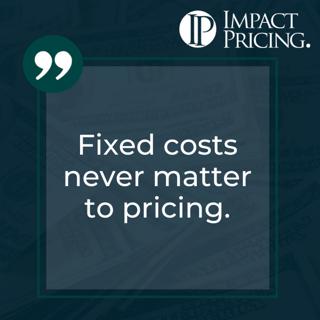
Memecast #52: Fixed Costs
This one may be intuitive, may not be intuitive, but it turns out that if your fixed costs change, for whatever reason, if they go up, if they go down, it really should have no impact whatsoever on your pricing. For example, let's say you need to buy a new piece of factory equipment, and it's really expensive, and it makes your fixed cost go way up. Did buying that new piece of factory equipment for you change your customer's willingness to pay? No, it didn't. Customers are still willing to pay the same amount. They still can choose between you and a competitor. Well, did you changing your fixed costs changed the way your competitor prices for whatever reason? No, it doesn't. The only thing that matters to us when we're doing pricing is thinking about how our customers are making decisions and how we can make optimal decisions based on that. And I can assure you that your fixed costs have absolutely nothing to do with how much your customers are willing to pay. For that reason, your fixed costs never matter to pricing. We hope you enjoyed this memecast. If you have any questions or feedback, please email me mark@impactpricing.com. Now, go make an impact. Connect with Mark Stiving: Email: mark@impactpricing.com LinkedIn: https://www.linkedin.com/in/stiving/
6 Huhti 20221min
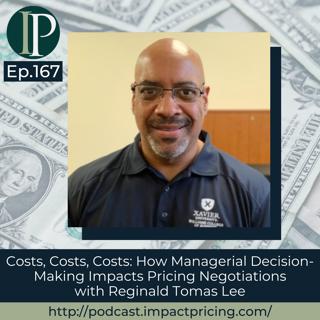
Costs, Costs, Costs: How Managerial Decision-Making Impacts Pricing Negotiations with Reginald Tomas Lee
Reginald Tomas Lee is a Professor of Business Analytics at Xavier University in Cincinnati, Ohio. He has a PhD in Mechanical Engineering, and he's been involved in supply chain since ’96. Reginald’s most recent book is called Project Profitability. And one fun thing, he can't go on vacation, because he has two killer dogs. In this episode, Reginald shares wisdom with regards to the modeling he’s been making as he talks about the power of helping people understand more clearly how what it is that they do impacts cash. Why you have to check out today’s podcast: Understand why you should start seeing things from a cash perspective in relation to knowing what it is that it enables you to save Learn about the difference of cash cost and non-cash cost through situational examples from real life experiences Find out how your actions and decisions impact how you generate cash in a business “Don’t focus on accounting margins.” – Reginald Tomas Lee Topics Covered: 01:17 – How Reginald shifted from being a mechanical engineer to thinking about supply chains and costing 03:44 – What Reginald does: Helping people understand how their decisions impact cash 07:18 – Talking about contribution margins: Accounting for things from a cash perspective 11:09 – How to figure out the optimal price without using some measure of contribution margin 14:34 – Hope as a strategy: Mark’s opportunity cost vs. Reginald’s opportunity revenue 17:15 – Two types of costs: The cash cost and the non-cash cost 21:41 – Reginald’s sales pitch: Very specifically identifying what the savings are 24:02 – Discussion about Mark’s value table and Reginald’s improvement projects 27:59 – Projecting revenue and the uncertainty that comes with it 30:24 – Reginald’s piece of pricing advice for today’s listeners Key Takeaways: “We should shift away from looking at accounting data and look specifically at operations and cash.” – Reginald Tomas Lee “From a cash perspective, materials and labor don't vary. When we look at contribution margins for products that we make, and we assume that those costs vary and they affect the contribution margin, my argument is they don't vary. And so therefore, it's not a reflection of cash.” – Reginald Tomas Lee “As we know, hope’s not a strategy. We’re hoping that the demand would be there, but I've seen situations, actually, where people have bought more just to get a lower price so that they can report a higher gross margin. It's not a good business decision at all. And that's why I shift over to cash, because cash will tell you don't do that, but accounting may, because I can put it in inventory.” – Reginald Tomas Lee “If you want to save money, what you have to do is basically buy fewer people. Buy four people instead of buying 10 people. Buy less capacity, then I'm spending less money.” – Reginald Tomas Lee “I focus specifically on what changes the software will enable, and then point out that if you want the cash savings, you need to make managerial decisions. You have to make a decision to get rid of the four people because the software is not going to fire them. That's what you have to do. The software is not making the cost savings happen. It's my management decision and action that was at that.” – Reginald Tomas Lee “I define efficiency as engineers do – output over input. So, if my input is my organization, what I'm spending on the organization, and the output is what it is that they can do, then what this will do is that we’ll generally allow them to either create more output with the same group, or consume less of that group to create the existing amount of output. But the size of the organization itself doesn't change until I, as a manager, change it.” – Reginald Tomas Lee “Based on how we choose to calculate this cost, that may have an impact on whether we take the business or not. So instead of focusing on accounting margins, if you can take a look at the cash impact of the decision that you make, then I think you'll be in a much better position to be able to negotiate price and feel good about taking prices that in some cases you may not have taken just because someone calculated a number that happen to be lower than someone else's calculation.” – Reginald Tomas Lee People / Resources Mentioned: Project Profitability: https://www.amazon.com/Project-Profitability-Ensuring-Improvement-Projects/dp/1637421699 The Goal: https://www.amazon.com/Goal-Process-Ongoing-Improvement/dp/0884271951 Connect with Reginald Tomas Lee: Email: reginald.lee@bdrco.org LinkedIn: https://www.linkedin.com/in/reginaldtomas/ Connect with Mark Stiving: LinkedIn: https://www.linkedin.com/in/stiving/ Email: mark@impactpricing.com
4 Huhti 202232min

Blogcast #48: Direct Customer Impact
This is an Impact Pricing Blog published on February 23, 2022, turned into an audio podcast so you can listen on the go. Read Full Article Here: https://impactpricing.com/blog/direct-customer-impact/ If you have any feedback, definitely send it. You can reach us at mark@impactpricing.com. Now, go make an impact. Connect with Mark Stiving: Email: mark@impactpricing.com LinkedIn: https://www.linkedin.com/in/stiving/
1 Huhti 20223min
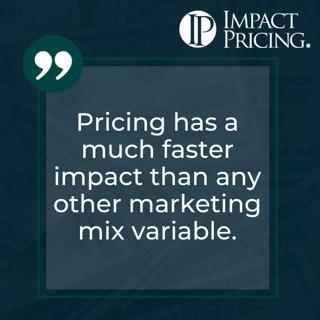
Memecast #51: Price is Fast
It's true, pricing can have an instantaneous response. I often think of it as the nuclear bomb of marketing mix variables because you can change it today, impact the market immediately, and it's really hard to take it back. Now, compare that to the other marketing mix variables. If you've taken a marketing class, you know the four P's. You know the other three besides price, or your product, your place, and your promotion. Product is obviously, what are we building? The place is, what's the distribution channel look like? And then the promotion is, how are we marketing it? How are we talking about it in the marketplace? We could change our marketing. We could change our product. We could change our distribution channel. And each one of those would have an impact on our revenue, on our sales. But it takes a long time for that impact to ripple through. On the other hand, if I change price today, people will change their mind today. Some people will choose to buy, some people will choose not to buy, simply because of the price change. So price really does have the fastest impact, but it also is one of the most dangerous to use. If you're using price to gain share, you're probably just driving industry profits down. So, although it's fast, be very careful how you use it. We hope you enjoyed this memecast. If you have any questions or feedback, please email me mark@impactpricing.com. Now, go make an impact. Connect with Mark Stiving: Email: mark@impactpricing.com LinkedIn: https://www.linkedin.com/in/stiving/
30 Maalis 20222min
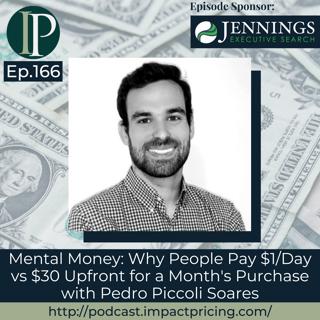
Mental Money: Why People Pay $1/Day vs $30 Upfront for a Month's Purchase with Pedro Piccoli Soares
Pedro Piccoli Soares is currently Senior Executive Manager of AI Pricing at SIXT, a travel arrangement / car rental company that’s known to be a provider of high-quality mobility services. He mentors startups, and has an Engineering degree. He also has a purple belt in Brazilian jiu-jitsu. In this episode, Pedro shares his knowledge when it comes to behavioral economics as he and Mark talk about how it works in relation to mental accounting and pricing. Why you have to check out today’s podcast: Discover why it’s important for companies to understand why they’re doing pricing and why they’re having a price change Understand why you should still be relative to your competitors’ price change even when they’ve already made the mistake of decreasing their prices Learn more about behavioral economics, its tactics, and its relationship with mental accounting and pricing “So, we've mentioned several different effects of behavioral economics and several different examples of how they can be applied on real business. If you think about it, they were quite simple, right? It's really easy to test these kinds of things, and they can generate some really nice benefits to your company, for sure.” – Pedro Piccoli Soares Topics Covered: 01:40 – The internship that led to Pedro’s shift from being an Engineer to doing pricing 03:09 – What Pedro loves about pricing that made him stay in it 05:34 – Why it’s important for companies to understand why they’re doing pricing and why they’re having a price change 07:38 – Being relative to competitors’ price change even when they made the wrong decision 10:20 – Talking about behavioral economics; what Mark doesn’t like about it 12:33 – Behavioral economics’ tricks: Pedro and Mark’s perspectives in relation to price endings in relation to mental accounting 18:49 – Discussion about what loss aversion is 20:38 – The use and importance of loss aversion, especially in business 23:23 – Behavioral economics and people’s buying decisions in relation to good, better, best 25:53 – Pedro’s piece of pricing advice for today’s listeners Key Takeaways: “This is when you kind of lose the sense of why you're doing the price change. If you just follow your competition, if you don't know the reason why you're changing the prices, you can initiate a fight that in the end has no background or no reason to be happening. You are assuming that everything that they are doing is right, and that they know why they are changing prices. It might be the case, but might be the case that they are also doing something wrong and you're just following them. You need to understand your customers and what price changes will affect them. You need to have a reasoning you apply when you’re changing the price.” – Pedro Piccoli Soares “I totally agree that behavioral economics cannot generate as much value as pricing departments can generate. And it’s, on the other hand, a much nicer topic to talk about to show results. You can definitely play around and create experiments, and you can very easily show the results of a try, and it's something that calls people attention because it's actually behavior, and that's something that they do as well, right? So, everybody wants to listen and to hear about heuristics, or the mistakes, the biases that they take when they're making decisions. And that's why I think it's a topic that costs more attention than pricing.” – Pedro Piccoli Soares “When you have two different people, we have so many different characteristics that it's harder to compare. And if you have just two similar options, one, which is clearly worse than the other, you make the choice easier.” – Pedro Piccoli Soares People / Resources Mentioned: SIXT: https://www.sixt.com/ Dan Ariely: https://danariely.com/ Connect with Pedro Piccoli Soares: LinkedIn: https://www.linkedin.com/in/pedro-piccoli-soares/ Email: piccolisoares@gmail.com Connect with Mark Stiving: LinkedIn: https://www.linkedin.com/in/stiving/ Email: mark@impactpricing.com
28 Maalis 202228min













